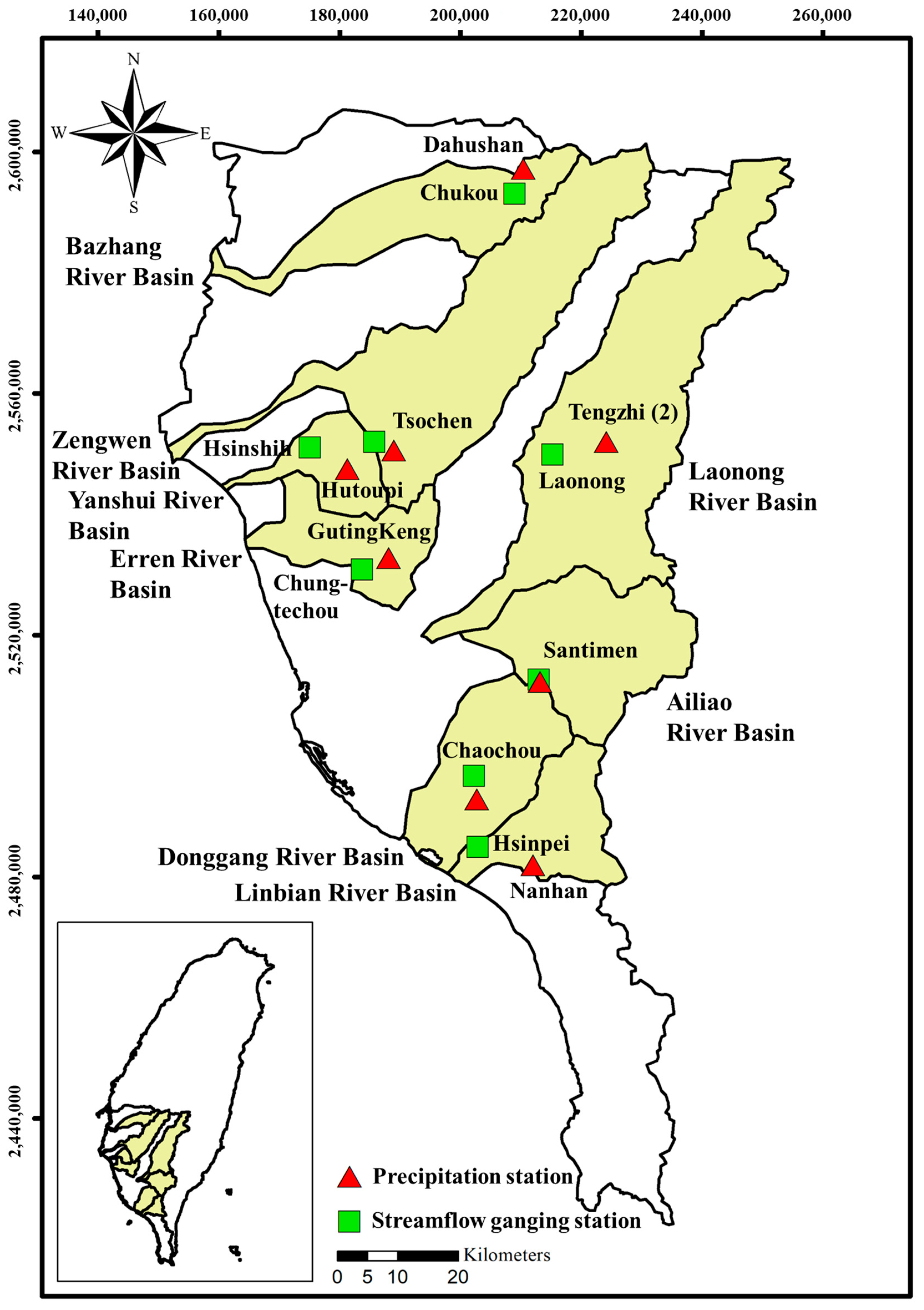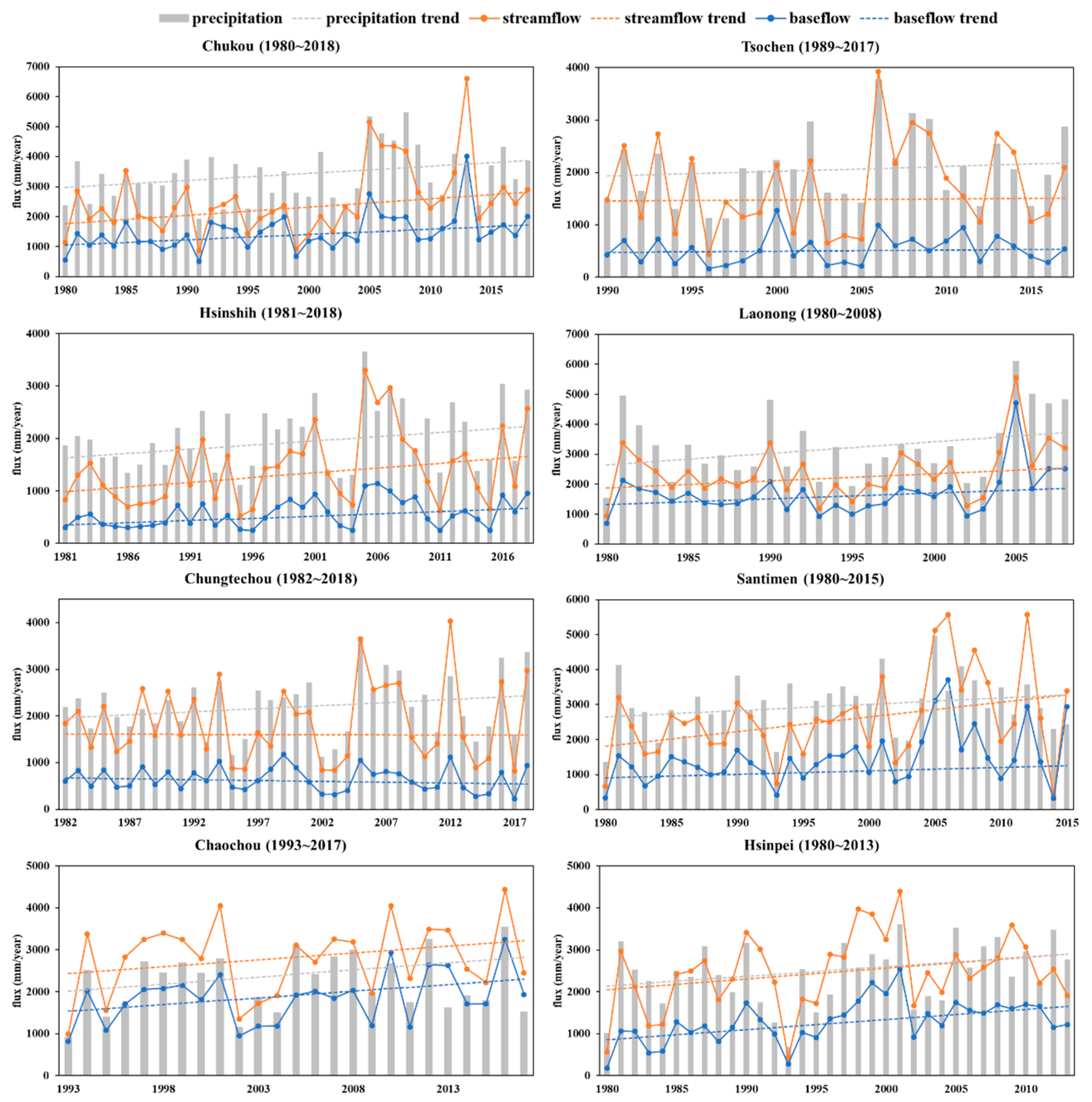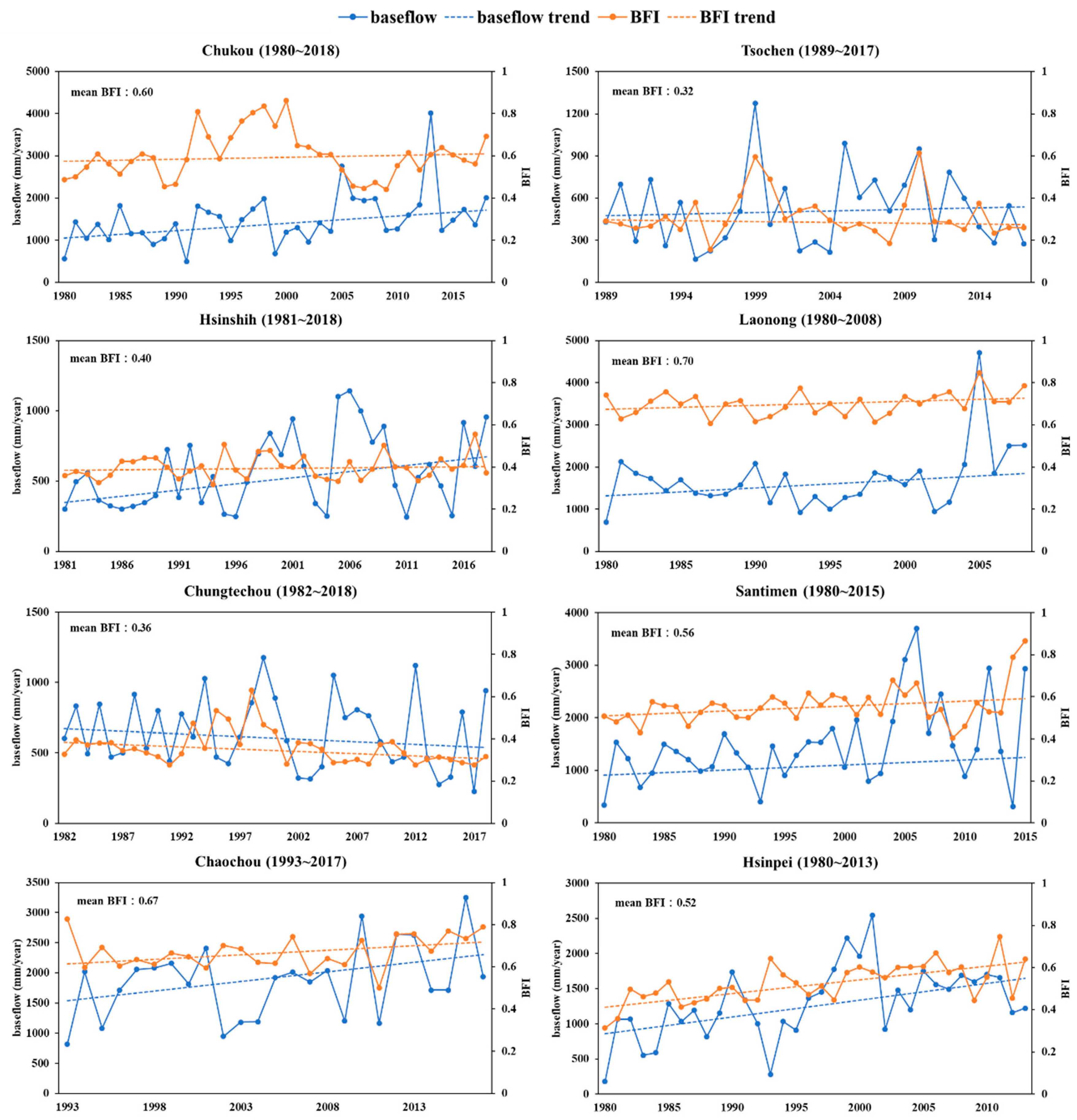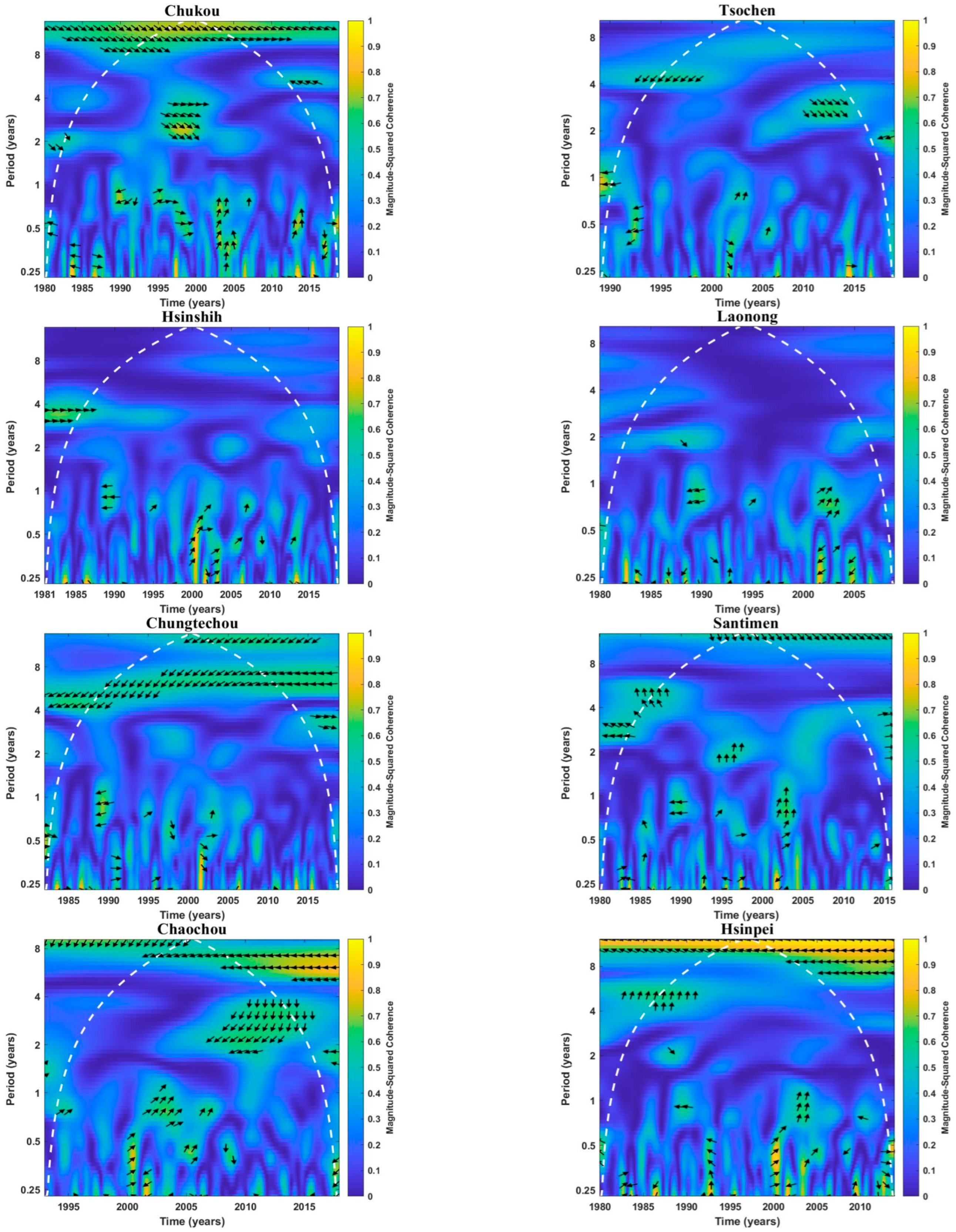Baseflow Variation in Southern Taiwan Basin
Abstract
1. Introduction
2. Materials and Methods
2.1. Study Area and Data Sources
2.2. Methodology
2.2.1. Baseflow Separation
2.2.2. Partial Correlation Analysis
2.2.3. Baseflow Attribution Analysis
Sensitivity Analysis
Multiple Linear Regression Analysis
Budyko Hypothesis
2.2.4. Wavelet Analysis
3. Results and Discussion
3.1. Hydrological Variation Analysis
3.2. Partial Correlation Analysis
3.3. Attribution Analysis of Baseflow
3.3.1. Sensitivity Analysis
3.3.2. Analysis of n Values in Budyko Hypothesis
| Stations | Precipitation | Evaporation | Budyko Hypothesis n Value | |||
|---|---|---|---|---|---|---|
| Fu [56] | Zhang et al. [57] | Choudhury [48] | Wang and Tang [54] | |||
| Chukou | 0.96 | 1.42 | 0.01 | −0.29 | −0.01 | 0.35 |
| Tsochen | 1.08 | 2.14 | −0.25 | −0.44 | −0.18 | 0.19 |
| Hsinshih | 1.24 | 2.97 | −0.02 | −0.23 | −0.03 | 0.65 |
| Laonong | 1.1 | 2.59 | −0.19 | −0.43 | −0.16 | 0.89 |
| Chungtechou | 1.03 | 0.92 | −0.40 | −0.37 | −0.33 | −0.10 |
| Santimen | 1.18 | 2.63 | −0.07 | −0.39 | −0.07 | 0.68 |
| Chaochou | 0.81 | 0.83 | −0.18 | −0.27 | −0.17 | −0.18 |
| Hsinpei | 0.85 | 1.44 | 0.08 | −0.17 | 0.06 | 0.31 |
3.3.3. Attribution Analysis of Baseflow Change
3.4. Wavelet Coherence of Baseflow and ENSO
3.5. Wavelet Coherence of Baseflow and PDO
3.6. Uncertainty Analysis
4. Conclusions
Author Contributions
Funding
Institutional Review Board Statement
Informed Consent Statement
Data Availability Statement
Conflicts of Interest
References
- Hodgkins, G.A.; Dudley, R.W. Historical summer base flow and stormflow trends for New England rivers. Water Resour. Res. 2011, 47. [Google Scholar] [CrossRef]
- Miller, M.P.; Susong, D.D.; Shope, C.L.; Heilweil, V.M.; Stolp, B.J. Continuous estimation of baseflow in snowmelt-dominated streams and rivers in the Upper Colorado River Basin: A chemical hydrograph separation approach. Water Resour. Res. 2014, 50, 6986–6999. [Google Scholar] [CrossRef]
- Ficklin, D.L.; Robeson, S.M.; Knouft, J.H. Impacts of recent climate change on trends in baseflow and stormflow in United States watersheds. Geophys. Res. Lett. 2016, 43, 5079–5088. [Google Scholar] [CrossRef]
- Price, K. Effects of watershed topography, soils, land use, and climate on baseflow hydrology in humid regions: A review. Prog. Phys. Geogr. Earth Environ. 2011, 35, 465–492. [Google Scholar] [CrossRef]
- Raffensperger, J.P.; Baker, A.C.; Blomquist, J.D.; Hopple, J.A. Optimal Hydrograph Separation Using a Recursive Digital Filter Constrained by Chemical Mass Balance, with Application to Selected Chesapeake Bay Watersheds (no. 2017-5034); US Geological Survey: Reston, VA, USA, 2017. [Google Scholar]
- Sun, W.; Song, X.; Zhang, Y.; Chiew, F.; Post, D.; Zheng, H.; Song, S. Coal Mining Impacts on Baseflow Detected Using Paired Catchments. Water Resour. Res. 2020, 56, e2019WR025770. [Google Scholar] [CrossRef]
- Li, Y.; Zhang, Q. Historical and predicted variations of baseflow in China’s Poyang Lake catchment. River Res. Appl. 2018, 34, 1286–1297. [Google Scholar] [CrossRef]
- Rumsey, C.A.; Miller, M.P.; Sexstone, G.A. Relating hydroclimatic change to streamflow, baseflow, and hydrologic partitioning in the Upper Rio Grande Basin, 1980 to 2015. J. Hydrol. 2020, 584, 124715. [Google Scholar] [CrossRef]
- Tan, X.; Liu, B.; Tan, X. Global changes in baseflow under the impacts of changing climate and vegetation. Water Resour. Res. 2020, 56, e2020WR027349. [Google Scholar] [CrossRef]
- Ayers, J.R.; Villarini, G.; Schilling, K.; Jones, C. On the statistical attribution of changes in monthly baseflow across the U.S. Midwest. J. Hydrol. 2021, 592, 125551. [Google Scholar] [CrossRef]
- Cheng, Q.; Zhong, F.; Wang, P. Baseflow dynamics and multivariate analysis using bivariate and multiple wavelet coherence in an alpine endorheic river basin (Northwest China). Sci. Total. Environ. 2021, 772, 145013. [Google Scholar] [CrossRef]
- Rumsey, C.A.; Miller, M.P.; Schwarz, G.E.; Hirsch, R.M.; Susong, D.D. The role of baseflow in dissolved solids delivery to streams in the Upper Colorado River Basin. Hydrol. Process. 2017, 31, 4705–4718. [Google Scholar] [CrossRef]
- Ahiablame, L.; Sheshukov, A.Y.; Rahmani, V.; Moriasi, D. Annual baseflow variations as influenced by climate variability and agricultural land use change in the Missouri River Basin. J. Hydrol. 2017, 551, 188–202. [Google Scholar] [CrossRef]
- Zhang, J.; Song, J.; Cheng, L.; Zheng, H.; Wang, Y.; Huai, B.; Sun, W.; Qi, S.; Zhao, P.; Wang, Y.; et al. Baseflow estimation for catchments in the Loess Plateau, China. J. Environ. Manag. 2019, 233, 264–270. [Google Scholar] [CrossRef]
- Fan, Y.; Chen, Y.; Liu, Y.; Li, W. Variation of baseflows in the headstreams of the Tarim River Basin during 1960–2007. J. Hydrol. 2013, 487, 98–108. [Google Scholar] [CrossRef]
- Gan, R.; Sun, L.; Luo, Y. Baseflow characteristics in alpine rivers—A multi-catchment analysis in Northwest China. J. Mt. Sci. 2015, 12, 614–625. [Google Scholar] [CrossRef]
- Rezaei, A.; Gurdak, J.J. Large-scale climate variability controls on climate, vegetation coverage, lake and groundwater storage in the Lake Urmia watershed using SSA and wavelet analysis. Sci. Total. Environ. 2020, 724, 138273. [Google Scholar] [CrossRef]
- Li, H.; Wang, W.; Fu, J.; Chen, Z.; Ning, Z.; Liu, Y. Quantifying the relative contribution of climate variability and human activities impacts on baseflow dynamics in the Tarim River Basin, Northwest China. J. Hydrol. Reg. Stud. 2021, 36, 100853. [Google Scholar] [CrossRef]
- Gonzales, A.L.; Nonner, J.; Heijkers, J.; Uhlenbrook, S. Comparison of different base flow separation methods in a lowland catchment. Hydrol. Earth Syst. Sci. 2009, 13, 2055–2068. [Google Scholar] [CrossRef]
- Kinkela, K.; Pearce, L.J. Assessment of baseflow seasonality and application to design flood events in southwest Western Australia. Australas. J. Water Resour. 2014, 18, 27–38. [Google Scholar] [CrossRef]
- Szilagyi, J.; Harvey, F.E.; Ayers, J.F. Regional Estimation of Base Recharge to Ground Water Using Water Balance and a Base-Flow Index. Groundwater 2003, 41, 504–513. [Google Scholar] [CrossRef]
- Collischonn, W.; Fan, F.M. Defining parameters for Eckhardt’s digital baseflow filter. Hydrol. Process. 2013, 27, 2614–2622. [Google Scholar] [CrossRef]
- Lyne, V.; Hollick, M. Stochastic time-variable rainfall-runoff modelling. In Institute of Engineers Australia National Conference; Institute of Engineers Australia: Barton, Australia, 1979; Volume 79, pp. 89–93. [Google Scholar]
- Eckhardt, K. A comparison of baseflow indices, which were calculated with seven different baseflow separation methods. J. Hydrol. 2008, 352, 168–173. [Google Scholar] [CrossRef]
- Sloto, R.A.; Crouse, M.Y. HYSEP: A computer program for streamflow hydrograph separation and analysis. Water-Resour. Investig. Rep. 1996, 96, 4040. [Google Scholar]
- Rutledge, A.T. Computer Programs for Describing the Recession of Ground-Water Discharge and for Estimating Mean Ground-Water Recharge and Discharge From Streamflow Records: Update (No. 98); US Department of the Interior; US Geological Survey: Reston, VA, USA, 1998. [Google Scholar]
- Techamahasaranont, J.; Shrestha, S.; Babel, M.S.; Shrestha, R.P.; Jourdain, D. Spatial and temporal variation in the trends of hydrological response of forested watersheds in Thailand. Environ. Earth Sci. 2017, 76, 430. [Google Scholar] [CrossRef]
- Lucas, M.; Kublik, N.; Rodrigues, D.; Neto, A.M.; Almagro, A.; Melo, D.; Zipper, S.; Oliveira, P. Significant Baseflow Reduction in the Sao Francisco River Basin. Water 2020, 13, 2. [Google Scholar] [CrossRef]
- Hu, C.; Zhao, D.; Jian, S. Baseflow estimation in typical catchments in the Yellow River Basin, China. Water Supply 2021, 21, 648–667. [Google Scholar] [CrossRef]
- Water Resource Agency. Hydrology Annual Report; Water Resource Agency, MOEA: Taipei, Taiwan, 2020. [Google Scholar]
- Taiwan Waterworks Statistical Annual Report, Taiwan Waterworks Statistical Annual Report; Taiwan Water Corporation: Taipei, Taiwan, 2020.
- Huang, S.-H.; Mahmud, K.; Chen, C.-J. Meaningful Trend in Climate Time Series: A Discussion Based on Linear and Smoothing Techniques for Drought Analysis in Taiwan. Atmosphere 2022, 13, 444. [Google Scholar] [CrossRef]
- Yeh, H.; Huang, C. Evaluation of basin storage–discharge sensitivity in Taiwan using low-flow recession analysis. Hydrol. Process. 2019, 33, 1434–1447. [Google Scholar] [CrossRef]
- Martens, B.; Gonzalez Miralles, D.; Lievens, H.; Van Der Schalie, R.; De Jeu, R.A.M.; Fernández-Prieto, D.; Beck, H.E.; Dorigo, W.A.; Verhoest, N.E.C. GLEAM v3: Satellite-based land evaporation and root-zone soil moisture. Geosci. Model Dev. 2017, 10, 1903–1925. [Google Scholar] [CrossRef]
- Tsao, J.; Lee, C.-H.; Yeh, H.-F. Attribution of Streamflow Variations in Southern Taiwan. Water 2020, 12, 2465. [Google Scholar] [CrossRef]
- Mantua, N.J.; Hare, S.R.; Zhang, Y.; Wallace, J.M.; Francis, R.C. A Pacific interdecadal climate oscillation with impacts on salmon production. Bull. Am. Meteorol. Soc. 1997, 78, 1069–1080. [Google Scholar] [CrossRef]
- Mann, H.B. Nonparametric tests against trend. Econometrica. J. Econom. Soc. 1945, 13, 245–259. [Google Scholar] [CrossRef]
- Kendall, M.G. Rank Correlation Methods; Richard Griffin & Co.: Glasgow, Scotland, 1948. [Google Scholar] [CrossRef]
- Sen, P.K. Estimates of the regression coefficient based on Kendall’s tau. J. Am. Stat. Assoc. 1968, 63, 1379–1389. [Google Scholar] [CrossRef]
- Theil, H. A rank-invariant method of linear and polynomial regression analysis. In Henri Theil’s Contributions to Economics and Econometrics; Springer: Dordrecht, The Netherlands, 1992. [Google Scholar]
- Pettitt, A.N. A non-parametric approach to the change-point problem. J. R. Stat. Soc. Ser. C 1979, 28, 126–135. [Google Scholar] [CrossRef]
- Baba, K.; Shibata, R.; Sibuya, M. Partial correlation and conditional correlation as measures of conditional independence. Aust. N. Z. J. Stat. 2004, 46, 657–664. [Google Scholar] [CrossRef]
- Schaake, J.C. From climate to flow. In Climate Change and US Water Resources; John Wiley: New York, UY, USA, 1990; pp. 177–206. [Google Scholar]
- Zheng, H.; Zhang, L.; Zhu, R.; Liu, C.; Sato, Y.; Fukushima, Y. Responses of streamflow to climate and land surface change in the headwaters of the Yellow River Basin. Water Resour. Res. 2009, 45. [Google Scholar] [CrossRef]
- Kim, J.H.; Jackson, R.B. A Global Analysis of Groundwater Recharge for Vegetation, Climate, and Soils. Vadose Zone J. 2012, 11, vzj2011.0021RA. [Google Scholar] [CrossRef]
- Sharifi, A.; Mirabbasi, R.; Nasr-Esfahani, M.A.; Haghighi, A.T.; Nafchi, R.F. Quantifying the impacts of anthropogenic changes and climate variability on runoff changes in central plateau of Iran using nine methods. J. Hydrol. 2021, 603, 127045. [Google Scholar] [CrossRef]
- Budyko, M.I. Climate and Life; Academic Press: Cambridge, MA, USA, 1974. [Google Scholar]
- Choudhury, B. Evaluation of an empirical equation for annual evaporation using field observations and results from a biophysical model. J. Hydrol. 1999, 216, 99–110. [Google Scholar] [CrossRef]
- Schreiber, P. Über die Beziehungen zwischen dem Niederschlag und der Wasserführung der Flüsse in Mitteleuropa. Z. Meteorol. 1904, 21, 441–452. (In German) [Google Scholar]
- Nathan, R.J.; McMahon, T.A. Evaluation of automated techniques for base flow and recession analyses. Water Resour. Res. 1990, 26, 1465–1473. [Google Scholar] [CrossRef]
- Longobardi, A.; Villani, P. Baseflow index regionalization analysis in a mediterranean area and data scarcity context: Role of the catchment permeability index. J. Hydrol. 2008, 355, 63–75. [Google Scholar] [CrossRef]
- Sawicz, K.; Wagener, T.; Sivapalan, M.; Troch, P.A.; Carrillo, G. Catchment classification: Empirical analysis of hydrologic similarity based on catchment function in the eastern USA. Hydrol. Earth Syst. Sci. 2011, 15, 2895–2911. [Google Scholar] [CrossRef]
- Yang, H.; Yang, D.; Lei, Z.; Sun, F. New analytical derivation of the mean annual water-energy balance equation. Water Resour. Res. 2008, 44, 893–897. [Google Scholar] [CrossRef]
- Wang, D.; Tang, Y. A one-parameter Budyko model for water balance captures emergent behavior in darwinian hydrologic models. Geophys. Res. Lett. 2014, 41, 4569–4577. [Google Scholar] [CrossRef]
- Liang, W.; Bai, D.; Wang, F.; Fu, B.; Yan, J.; Wang, S.; Yang, Y.; Long, D.; Feng, M. Quantifying the impacts of climate change and ecological restoration on streamflow changes based on a Budyko hydrological model in China’s Loess Plateau. Water Resour. Res. 2015, 51, 6500–6519. [Google Scholar] [CrossRef]
- Fu, B.P. On the calculation of the evaporation from land surface. Chin. J. Atmos. Sci. 1981, 1, 002. (In Chinese) [Google Scholar]
- Zhang, L.; Dawes, W.R.; Walker, G.R. Response of mean annual evapotranspiration to vegetation changes at catchment scale. Water Resour. Res. 2001, 37, 701–708. [Google Scholar] [CrossRef]
- Mo, C.; Ruan, Y.; Xiao, X.; Lan, H.; Jin, J. Impact of climate change and human activities on the baseflow in a typical karst basin, Southwest China. Ecol. Indic. 2021, 126, 107628. [Google Scholar] [CrossRef]
- Grinsted, A.; Moore, J.C.; Jevrejeva, S. Application of the cross wavelet transform and wavelet coherence to geophysical time series. Nonlinear Process. Geophys. 2004, 11, 561–566. [Google Scholar] [CrossRef]
- Xu, X.; Yang, D.; Yang, H.; Lei, H. Attribution analysis based on the Budyko hypothesis for detecting the dominant cause of runoff decline in Haihe basin. J. Hydrol. 2014, 510, 530–540. [Google Scholar] [CrossRef]
- Statistical Yearbook of Interior. In The Annual Report of Internal Affairs Statistics E-Book in 108 Year; Statistics Department of the Ministry of the Interior: Taipei, Taiwan, 2019.
- Chen, L.Q.; Liu, C.M.; Li, F.D. Review on basic flow researches. Progr. Geogr. 2006, 13, 1–15. (In Chinese) [Google Scholar]
- Zhao, G.; Tian, P.; Mu, X.; Jiao, J.; Wang, F.; Gao, P. Quantifying the impact of climate variability and human activities on streamflow in the middle reaches of the Yellow River basin, China. J. Hydrol. 2014, 519, 387–398. [Google Scholar] [CrossRef]
- Wu, J.; Miao, C.; Zhang, X.; Yang, T.; Duan, Q. Detecting the quantitative hydrological response to changes in climate and human activities. Sci. Total Environ. 2017, 586, 328–337. [Google Scholar] [CrossRef]
- Wu, J.; Miao, C.; Duan, Q.; Lei, X.; Li, X.; Li, H. Dynamics and Attributions of Baseflow in the Semiarid Loess Plateau. J. Geophys. Res. Atmos. 2019, 124, 3684–3701. [Google Scholar] [CrossRef]
- Li, Z.; Liu, W.; Zhang, J.; Zheng, F.-L. Impacts of land use change and climate variability on hydrology in an agricultural catchment on the Loess Plateau of China. J. Hydrol. 2009, 377, 35–42. [Google Scholar] [CrossRef]
- Miao, C.; Ni, J.; Borthwick, A.G.; Yang, L. A preliminary estimate of human and natural contributions to the changes in water discharge and sediment load in the Yellow River. Glob. Planet. Chang. 2011, 76, 196–205. [Google Scholar] [CrossRef]
- Kong, D.; Miao, C.; Wu, J.; Duan, Q. Impact assessment of climate change and human activities on net runoff in the Yellow River Basin from 1951 to 2012. Ecol. Eng. 2016, 91, 566–573. [Google Scholar] [CrossRef]
- Xie, Z.; Mu, X.; Gao, P.; Wu, C.; Qiu, D. Impacts of Climate and Anthropogenic Activities on Streamflow Regimes in the Beiluo River, China. Water 2021, 13, 2892. [Google Scholar] [CrossRef]
- Mu, Z.; Liu, G.; Lin, S.; Fan, J.; Qin, T.; Li, Y.; Cheng, Y.; Zhou, B. Base Flow Variation and Attribution Analysis Based on the Budyko Theory in the Weihe River Basin. Water 2022, 14, 334. [Google Scholar] [CrossRef]
- Wang, D.; Cai, X. Comparative study of climate and human impacts on seasonal baseflow in urban and agricultural watersheds. Geophys. Res. Lett. 2010, 37. [Google Scholar] [CrossRef]
- Yang, Q.; Li, Z.; Han, Y.; Gao, H. Responses of Baseflow to Ecological Construction and Climate Change in Different Geomorphological Types in The Middle Yellow River, China. Water 2020, 12, 304. [Google Scholar] [CrossRef]
- Aboelnour, M.; Gitau, M.W.; Engel, B.A. A Comparison of Streamflow and Baseflow Responses to Land-Use Change and the Variation in Climate Parameters Using SWAT. Water 2020, 12, 191. [Google Scholar] [CrossRef]
- Duan, W.; Song, L.; Li, Y.; Mao, J. Modulation of PDO on the predictability of the interannual variability of early summer rainfall over south China. J. Geophys. Res. Atmos. 2013, 118, 13008–13021. [Google Scholar] [CrossRef]
- Han, W.; Meehl, G.A.; Hu, A.; Alexander, M.A.; Yamagata, T.; Yuan, D.; Ishii, M.; Pegion, P.; Zheng, J.; Hamlington, B.D.; et al. Intensification of decadal and multi-decadal sea level variability in the western tropical Pacific during recent decades. Clim. Dyn. 2013, 43, 1357–1379. [Google Scholar] [CrossRef]
- Meehl, G.A.; Hu, A. Megadroughts in the Indian Monsoon Region and Southwest North America and a Mechanism for Associated Multidecadal Pacific Sea Surface Temperature Anomalies. J. Clim. 2006, 19, 1605–1623. [Google Scholar] [CrossRef]
- Yeh, S.-W.; Cai, W.; Min, S.-K.; McPhaden, M.J.; Dommenget, D.; Dewitte, B.; Collins, M.; Ashok, K.; An, S.-I.; Yim, B.-Y.; et al. ENSO Atmospheric Teleconnections and Their Response to Greenhouse Gas Forcing. Rev. Geophys. 2018, 56, 185–206. [Google Scholar] [CrossRef]
- Li, H.; Dai, A.; Zhou, T.; Lu, J. Responses of East Asian summer monsoon to historical SST and atmospheric forcing during 1950–2000. Clim. Dyn. 2010, 34, 501–514. [Google Scholar] [CrossRef]
- Wu, C.-R. Interannual modulation of the Pacific Decadal Oscillation (PDO) on the low-latitude western North Pacific. Prog. Oceanogr. 2013, 110, 49–58. [Google Scholar] [CrossRef]
- Gonsamo, A.; Chen, J.M.; Lombardozzi, D. Global vegetation productivity response to climatic oscillations during the satellite era. Glob. Chang. Biol. 2016, 22, 3414–3426. [Google Scholar] [CrossRef] [PubMed]
- Hung, C.-W.; Hsu, H.-H.; Lu, M.-M. Decadal oscillation of spring rain in northern Taiwan. Geophys. Res. Lett. 2004, 31. [Google Scholar] [CrossRef]
- Yue, S.; Wang, C.Y. Applicability of prewhitening to eliminate the influence of serial correlation on the Mann-Kendall test. Water Resour. Res. 2002, 38, 4-1–4-7. [Google Scholar] [CrossRef]
- Yue, S.; Pilon, P.; Phinney, B.; Cavadias, G. The influence of autocorrelation on the ability to detect trend in hydrological series. Hydrol. Process. 2002, 16, 1807–1829. [Google Scholar] [CrossRef]





| Basin | Basin Area (km2) | Mean Streamflow (mm/year) | Mean Precipitation (mm/year) | Study Year | Streamflow Station | Precipitation Station | ||||
|---|---|---|---|---|---|---|---|---|---|---|
| Station | TWD67_X | TWD67_Y | Station | TWD67_X | TWD67_Y | |||||
| Bazhang River | 408.1 | 2539.2 | 3394.6 | 1980~2018 | Chukou | 208,946.8 | 2,593,107 | Dahushan | 210,373.7 | 2,597,161 |
| Zengwen River | 121.3 | 1705.4 | 2056.3 | 1989~2017 | Tsochen | 185,724.9 | 2,552,024 | Tsochen | 188,947 | 2,550,518 |
| Yanshui River | 812 | 1436 | 2040.7 | 1981~2018 | Hsinshih | 175,074.3 | 2,551,130 | Hutoupi | 181,234.8 | 2,547,490 |
| Laonong River | 146.5 | 2406.8 | 3277.5 | 1980~2008 | Laoning | 215,270 | 2,549,901 | Tengzhi (2) | 224,105 | 2,551,973 |
| Erren River | 139.6 | 1864.9 | 2208.5 | 1982~2018 | Chungtechou | 183,721.8 | 2,530,866 | Gutingkeng | 188,079.1 | 2,532,743 |
| Ailiao River | 309.9 | 2629.9 | 2990.6 | 1980~2015 | Santimen | 212,975.3 | 2,512,663 | Santimen | 213,138.6 | 2,512,242 |
| Donggang River | 175.3 | 2789.3 | 2230.7 | 1993~2017 | Chaochou | 202,242 | 2,496,785 | Chaochou | 202,683.6 | 2,492,808.8 |
| Linbian River | 83.2 | 2465.7 | 2428.3 | 1980~2013 | Hsinpei | 202,878.9 | 2,484,988 | Nanhan | 211,948.6 | 2,481,928 |
| Model | Formula | |
|---|---|---|
| Fu [56] | (11) | |
| Choudhury [48] | (12) | |
| Zhang et al. [57] | (13) | |
| Wang and Tang [54] | (14) |
| Station | Study Year | MK-Test (Z) | Sen’s Slope β (mm/year) | ||||
|---|---|---|---|---|---|---|---|
| Streamflow | Baseflow | Precipitation | Streamflow | Baseflow | Precipitation | ||
| Chukou | 1980~2018 | 2.49 * | 2.78 * | 1.89 | 27.53 | 17.54 | 23.62 |
| Tsochen | 1989~2017 | 0.38 | 0.49 | 0.58 | 2.08 | 2.17 | 9.28 |
| Hsinshih | 1981~2018 | 1.84 | 2.09 * | 1.45 | 18.19 | 8.75 | 16.00 |
| Laonong | 1980~2008 | 1.22 | 1.33 | 1.29 | 23.61 | 19.10 | 38.66 |
| Chungtechou | 1982~2018 | −0.04 | −1.11 | 1.03 | −0.61 | −3.69 | 13.15 |
| Santimen | 1980~2015 | 2.22 * | 2.14 * | 1.65 | 42.15 | 9.71 | 18.12 |
| Chaochou | 1993~2017 | 1.54 | 2.20 * | 0.77 | 32.30 | 31.80 | 33.71 |
| Hsinpei | 1980~2013 | 1.57 | 3.32 * | 1.83 | 25.71 | 23.90 | 23.00 |
| Station | Period * | Baseflow (mm/year) | Change (mm/year) | Change Rate (%) |
|---|---|---|---|---|
| Chukou | 1980~2003 | 1258.47 | 586.62 | 46.6% |
| 2004~2018 | 1845.09 | |||
| Tsochen | 1989~2003 | 471.43 | 92.01 | 19.5% |
| 2004~2017 | 563.44 | |||
| Hsinshih | 1981~1995 | 427.36 | 227.89 | 53.3% |
| 1996~2018 | 655.25 | |||
| Laonong | 1980~2002 | 1483.87 | 986.2 | 66.5% |
| 2003~2008 | 2470.07 | |||
| Chungtechou | 1982~1999 | 689.27 | −82.56 | −12.0% |
| 2000~2018 | 606.71 | |||
| Santimen | 1980~1995 | 1107.96 | 648.93 | 58.6% |
| 1996~2015 | 1756.89 | |||
| Chaochou | 1993~2008 | 1705.84 | 426.12 | 25.0% |
| 2009~2017 | 2131.96 | |||
| Hsinpei | 1980~1994 | 954.78 | 606.38 | 63.5% |
| 1995~2013 | 1561.16 |
| Variables | Correlation and Partial Correlation | Chukou | Tsochen | Hsinshih | Laoning | Chungtechou | Santimen | Chaochou | Hsinpei |
|---|---|---|---|---|---|---|---|---|---|
| P | Correlation E | 0.528 ** | 0.544 ** | 0.513 ** | 0.584 ** | 0.487 ** | 0.388 * | 0.296 | 0.297 |
| Streamflow | Correlation P | 0.720 ** | 0.852 ** | 0.893 ** | 0.912 ** | 0.860 ** | 0.708 ** | 0.832 ** | 0.677 ** |
| Correlation E | 0.497 ** | 0.417 * | 0.563 ** | 0.585 ** | 0.386 * | 0.550 ** | 0.169 | 0.194 | |
| Partial correlation P | 0.621 ** | 0.819 ** | 0.852 ** | 0.867 ** | 0.834 ** | 0.643 ** | 0.831 ** | 0.662 ** | |
| Partial correlation E | 0.198 | −0.105 | 0.271 | 0.155 | −0.074 | 0.423 * | −0.146 | −0.01 | |
| Baseflow | Correlation P | 0.583 ** | 0.660 ** | 0.808 ** | 0.861 ** | 0.762* | 0.602 ** | 0.754 ** | 0.673 ** |
| Correlation E | 0.386 * | 0.363 | 0.613 ** | 0.618 ** | 0.224 | 0.524 ** | 0.215 | 0.338 | |
| Partial correlation P | 0.484 ** | 0.592 ** | 0.728 ** | 0.784 ** | 0.767 ** | 0.508 ** | 0.740 ** | 0.637 ** | |
| Partial correlation E | 0.113 | 0.005 | 0.393 * | 0.278 | −0.26 | 0.395 * | −0.013 | 0.196 | |
| BFI | Correlation P | −0.361 * | −0.142 | −0.335 * | 0.003 | −0.34 | −0.119 | −0.23 | 0.114 |
| Correlation E | −0.31 | 0.053 | 0.155 | 0.331 | −0.350 * | 0.139 | 0.049 | 0.359 * | |
| Partial correlation P | −0.245 | −0.204 | −0.489 ** | −0.249 | −0.207 | −0.19 | −0.256 | 0.008 | |
| Partial correlation E | −0.151 | 0.157 | 0.404 * | 0.406 * | −0.225 | 0.203 | 0.125 | 0.343 |
Disclaimer/Publisher’s Note: The statements, opinions and data contained in all publications are solely those of the individual author(s) and contributor(s) and not of MDPI and/or the editor(s). MDPI and/or the editor(s) disclaim responsibility for any injury to people or property resulting from any ideas, methods, instructions or products referred to in the content. |
© 2023 by the authors. Licensee MDPI, Basel, Switzerland. This article is an open access article distributed under the terms and conditions of the Creative Commons Attribution (CC BY) license (https://creativecommons.org/licenses/by/4.0/).
Share and Cite
Chen, H.-Y.; Hsu, Y.-H.; Huang, C.-C.; Yeh, H.-F. Baseflow Variation in Southern Taiwan Basin. Sustainability 2023, 15, 3600. https://doi.org/10.3390/su15043600
Chen H-Y, Hsu Y-H, Huang C-C, Yeh H-F. Baseflow Variation in Southern Taiwan Basin. Sustainability. 2023; 15(4):3600. https://doi.org/10.3390/su15043600
Chicago/Turabian StyleChen, Hsin-Yu, Yu-Hsiang Hsu, Chia-Chi Huang, and Hsin-Fu Yeh. 2023. "Baseflow Variation in Southern Taiwan Basin" Sustainability 15, no. 4: 3600. https://doi.org/10.3390/su15043600
APA StyleChen, H.-Y., Hsu, Y.-H., Huang, C.-C., & Yeh, H.-F. (2023). Baseflow Variation in Southern Taiwan Basin. Sustainability, 15(4), 3600. https://doi.org/10.3390/su15043600









